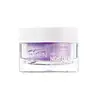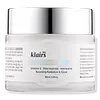What's inside
What's inside
 Key Ingredients
Key Ingredients

 Benefits
Benefits

 Concerns
Concerns

 Ingredients Side-by-side
Ingredients Side-by-side

Water
Skin ConditioningButylene Glycol
HumectantGlycerin
HumectantCoco-Caprylate/Caprate
Emollient1,2-Hexanediol
Skin ConditioningPropanediol
SolventCetyl Ethylhexanoate
EmollientAmmonium Acryloyldimethyltaurate/Vp Copolymer
Polyglyceryl-2 Stearate
EmulsifyingGlyceryl Stearate
EmollientHydroxyethyl Acrylate/Sodium Acryloyldimethyl Taurate Copolymer
Emulsion StabilisingStearyl Alcohol
EmollientAcrylates/C10-30 Alkyl Acrylate Crosspolymer
Emulsion StabilisingTromethamine
BufferingLavandula Angustifolia Oil
MaskingTocopheryl Acetate
AntioxidantGardenia Florida Fruit Extract
Skin ConditioningCyanocobalamin
Skin ConditioningLavandula Angustifolia Flower Extract
CleansingMaltodextrin
AbsorbentAscorbic Acid
AntioxidantMangifera Indica Seed Oil
EmollientPrunus Amygdalus Dulcis Oil
Skin ConditioningPersea Gratissima Oil
Skin ConditioningGlycine Soja Oil
EmollientJuglans Regia Seed Oil
Skin ConditioningHelianthus Annuus Seed Oil
EmollientLavandula Angustifolia Flower Water
Skin ConditioningTocopherol
AntioxidantEthylhexylglycerin
Skin ConditioningLinalool
PerfumingWater, Butylene Glycol, Glycerin, Coco-Caprylate/Caprate, 1,2-Hexanediol, Propanediol, Cetyl Ethylhexanoate, Ammonium Acryloyldimethyltaurate/Vp Copolymer, Polyglyceryl-2 Stearate, Glyceryl Stearate, Hydroxyethyl Acrylate/Sodium Acryloyldimethyl Taurate Copolymer, Stearyl Alcohol, Acrylates/C10-30 Alkyl Acrylate Crosspolymer, Tromethamine, Lavandula Angustifolia Oil, Tocopheryl Acetate, Gardenia Florida Fruit Extract, Cyanocobalamin, Lavandula Angustifolia Flower Extract, Maltodextrin, Ascorbic Acid, Mangifera Indica Seed Oil, Prunus Amygdalus Dulcis Oil, Persea Gratissima Oil, Glycine Soja Oil, Juglans Regia Seed Oil, Helianthus Annuus Seed Oil, Lavandula Angustifolia Flower Water, Tocopherol, Ethylhexylglycerin, Linalool
Water
Skin ConditioningGlycerin
HumectantButylene Glycol
HumectantTocopheryl Acetate
AntioxidantNiacinamide
SmoothingSodium Hyaluronate
HumectantCarrageenan
Gellan Gum
Betaine
HumectantAlgin
MaskingMannan
Ceramide NP
Skin ConditioningPEG-60 Hydrogenated Castor Oil
EmulsifyingAcrylates/C10-30 Alkyl Acrylate Crosspolymer
Emulsion StabilisingChlorphenesin
AntimicrobialArginine
MaskingEthylhexylglycerin
Skin ConditioningCentella Asiatica Extract
CleansingRubus Fruticosus Fruit Extract
AstringentSalicornia Herbacea Extract
Skin ConditioningPhragmites Communis Extract
Skin ConditioningAdenosine
Skin ConditioningLavandula Angustifolia Oil
MaskingEucalyptus Globulus Leaf Oil
PerfumingPelargonium Graveolens Flower Oil
MaskingCitrus Limon Peel Oil
MaskingCitrus Aurantium Dulcis Peel Oil
MaskingCananga Odorata Flower Oil
MaskingWater, Glycerin, Butylene Glycol, Tocopheryl Acetate, Niacinamide, Sodium Hyaluronate, Carrageenan, Gellan Gum, Betaine, Algin, Mannan, Ceramide NP, PEG-60 Hydrogenated Castor Oil, Acrylates/C10-30 Alkyl Acrylate Crosspolymer, Chlorphenesin, Arginine, Ethylhexylglycerin, Centella Asiatica Extract, Rubus Fruticosus Fruit Extract, Salicornia Herbacea Extract, Phragmites Communis Extract, Adenosine, Lavandula Angustifolia Oil, Eucalyptus Globulus Leaf Oil, Pelargonium Graveolens Flower Oil, Citrus Limon Peel Oil, Citrus Aurantium Dulcis Peel Oil, Cananga Odorata Flower Oil
 Reviews
Reviews

Ingredients Explained
These ingredients are found in both products.
Ingredients higher up in an ingredient list are typically present in a larger amount.
Acrylates/C10-30 Alkyl Acrylate Crosspolymer is a synthetic polymer. It is used to thicken and improve the texture of products. Due to its properties, it can prevent water and oil ingredients from separating.
Butylene Glycol (or BG) is used within cosmetic products for a few different reasons:
Overall, Butylene Glycol is a safe and well-rounded ingredient that works well with other ingredients.
Though this ingredient works well with most skin types, some people with sensitive skin may experience a reaction such as allergic rashes, closed comedones, or itchiness.
Learn more about Butylene GlycolEthylhexylglycerin (we can't pronounce this either) is commonly used as a preservative and skin softener. It is derived from glyceryl.
You might see Ethylhexylglycerin often paired with other preservatives such as phenoxyethanol. Ethylhexylglycerin has been found to increase the effectiveness of these other preservatives.
Glycerin is already naturally found in your skin. It helps moisturize and protect your skin.
A study from 2016 found glycerin to be more effective as a humectant than AHAs and hyaluronic acid.
As a humectant, it helps the skin stay hydrated by pulling moisture to your skin. The low molecular weight of glycerin allows it to pull moisture into the deeper layers of your skin.
Hydrated skin improves your skin barrier; Your skin barrier helps protect against irritants and bacteria.
Glycerin has also been found to have antimicrobial and antiviral properties. Due to these properties, glycerin is often used in wound and burn treatments.
In cosmetics, glycerin is usually derived from plants such as soybean or palm. However, it can also be sourced from animals, such as tallow or animal fat.
This ingredient is organic, colorless, odorless, and non-toxic.
Glycerin is the name for this ingredient in American English. British English uses Glycerol/Glycerine.
Learn more about GlycerinLavandula Angustifolia Oil is more commonly known as lavender essential oil. It is considered a fragrancing ingredient.
Lavender imparts a famous scent. While the smell is lovely, this ingredient and may sensitize skin in topical products. This is because about 85% of the oil is made up of linalool and linalyl acetate.
When exposed to air, these two compounds become strong allergens. This ingredient exhibits cytotoxicity at low concentrations; amounts of 0.25% have been shown to damage skin cells.
A study from Japan found this ingredient caused lavender sensitivity after widespread exposure.
Lavender essential oil has some antimicrobial, antibacterial, and anti-inflammatory properties. However, the cons of this ingredient may outweight the pros.
More research is needed to confirm lavender essential oil's effects when used in aromatherapy.
Lavandula Angustifolia is known as the English Lavender and famous for creating purple fields in Provence, France.
Learn more about Lavandula Angustifolia OilTocopheryl Acetate is AKA Vitamin E. It is an antioxidant and protects your skin from free radicals. Free radicals damage the skin by breaking down collagen.
One study found using Tocopheryl Acetate with Vitamin C decreased the number of sunburned cells.
Tocopheryl Acetate is commonly found in both skincare and dietary supplements.
Learn more about Tocopheryl AcetateWater. It's the most common cosmetic ingredient of all. You'll usually see it at the top of ingredient lists, meaning that it makes up the largest part of the product.
So why is it so popular? Water most often acts as a solvent - this means that it helps dissolve other ingredients into the formulation.
You'll also recognize water as that liquid we all need to stay alive. If you see this, drink a glass of water. Stay hydrated!
Learn more about Water